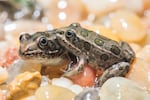
The northern leopard frog has been listed as endangered since 1999.
Courtesy of the Oregon Zoo
The Oregon Zoo’s conservation lab piloted a successful recovery program for the northern leopard frog, releasing hundreds of them in late July in a wildlife reserve near Eastern Washington’s Moses Lake.
The frogs, identified by their black-ringed green spots, have been listed as endangered since 1999 and only one known population remains in Washington’s Columbia National Wildlife Refuge, according to Hannah Anderson, the Endangered Species Section Manager at the Washington Department of Fish and Wildlife.
“One population is not a good situation for any species,” said Anderson. “So, we’ve been engaged in a process to sort of expand the distribution and increase the numbers of populations and one of the ways we’ve been doing that is through reintroduction.”
The Washington Department of Fish and Wildlife teamed up with the Oregon Zoo after being awarded a state grant to fund the head-starting program. The program helps endangered species recover in areas they no longer appear because of threats like invasive species, habitat loss, deforestation and pollution.
The first challenge was being at the right place at the right time to collect the eggs, Anderson said. Once biologists were able to locate them, only a small number of eggs were collected from different egg masses and transferred to the Oregon Zoo.
“The idea was, we would hatch out the eggs, we would keep the tadpoles safe and we would grow them all the way until they are frog stage,” the Oregon Zoo’s Senior Keeper Shelly Petit said. “At which point Washington Fish and Wildlife would come back, collect the frogs that we had grown and put them back in areas they used to be but are no longer.”
The project was launched on April 1 of this year. In late July, 237 frogs were released into a mesh netting-protected area in the Columbia National Wildlife Refuge, where biologist will be able to easily track and monitor the frogs that were part of the recovery program.
Once the frogs have acclimated to their new environment, the netting will be removed from the protected area, Petit said.
“Not only do we want to teach people about animals and everything but we also kind of want to walk the walk and work in conservation to help out our populations of our native species and recovery,” Petit said.
Later this month, Washington State University will be releasing an additional 250 northern leopard frogs after being able to take on the excess eggs that were brought back in April.
